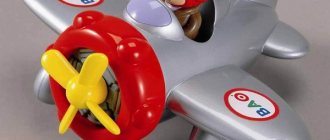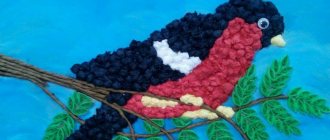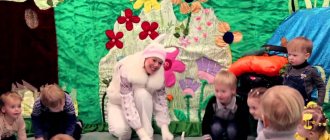Progress of organized educational activities.
In the group room there is a projector with a slide “Hares in a gray fur coat on the snow”
Educator: Guys, yesterday we helped forest animals survive the cold winter. They covered the bear with a snow blanket. And today look, we have new guests. Who is this?
Educator: That's right, Bunnies.
Educator: I wonder who came to us?
(Fox appears)
"Hello! Wow, so many bunnies, I’ll play hide and seek with them now. I turn my back and they hide.” Turns his back.
Educator: Guys, the bunnies are in danger. They must be hidden from the fox. Let's help them, otherwise the fox will catch them and eat them! Shall we help the bunnies?
Educator: What can we do to save the bunnies? It's winter outside, everything is covered with white snow. And the little hares in their gray fur coat stand out against the white snow. The bunnies did not have time to change their summer coats into winter ones.
Educator: What color is the fur of bunnies in winter?
Educator: Correct. The hare needs a white coat so that it is not visible in the snow. What other kind of fur do rabbits have? Right. She is fluffy, soft, warm.
Educator: I will show you how to draw the fur of a rabbit so that it is soft, fluffy, and warm. Go to the easel. (Children sit on chairs in front of the easel)
. To draw fluffy, soft fur for a bunny, you need to pick up a little white gouache with a brush, and, holding the brush vertically, make pokes inside the outline of the bunny. Demonstration of drawing methods by the teacher.
Educator: Guys, show me how to hold a brush. With three fingers, thumb and middle, holding it on top with the index finger, without squeezing too hard. Make pokes inside the outline of the bunny without going beyond the outline. (Show by children)
Educator: Bunnies also love it when it snows. Then they are completely invisible. It is soft and fluffy, like cotton wool.
The teacher takes a piece of cotton wool and blows on it.
Summary of a lesson on speech development in the second junior group “Bunny visiting the guys”
Summary of educational activities on speech development in kindergarten on the topic “Bunny visiting the children.”
Second junior group Author: Chernikova Natalya Valentinovna, teacher of MBDOU d/s No. 24 “Polyanka”, Kstovo, Nizhny Novgorod region Description of the material: the material can be useful for teachers when organizing organized educational activities on speech development with children of the second junior group when teaching storytelling toys. Goal: developing the ability to write a narrative story about toys. Tasks: - to train children to compose a story about toys with the help of a teacher; - develop the ability to answer questions; - activate adjectives in speech that denote the properties and qualities of objects; - develop speech breathing; - cultivate a friendly attitude towards the character. Methods: game for the development of speech breathing, didactic games, exercise, physical education. Tools: typesetting cloth, mnemonic diagram, pointer; didactic cards for the development of speech breathing “What is shown in the picture?”; bag, toys: hare, pyramid, car, ball. Preliminary work: - reading the fairy tale “Zayushkina’s Hut”, memorizing the nursery rhymes “Egorka the Hare”, A. Barto’s poem “Toys”, - examining toys: a hare, cars, nesting dolls, pyramids, writing stories about them, - organizing the outdoor game “Bunny” the little gray one is sitting,” didactic games: “Assemble a pyramid.” Vocabulary work: soft, fluffy long, short, fur.
OOD progress:
- Guys, today I went to kindergarten and met a bunny with a bag, he also ran to kindergarten.
Look, there he sits. /points to the bunny/ - Do you want to meet the bunny? (yes) /the teacher takes the bunny in his hands and brings it to the children/ - Do you want to look at the bunny? (yes) - What color is his fur coat? (white) - Do you want to touch the bunny and feel what kind of fur it has? I will come up to you and let each of you pet a bunny. /petting the bunny/ - Tell me, what does the bunny’s fur feel like to the touch? (the fur is soft, fluffy) /repeat the words in chorus, individually/ - What kind of ears does a bunny have? (long) - What kind of tail? (short) - Where does the bunny live? (in the forest) - Bunny, you had a bag. Where is he? /bunny shows the bag/ - This is the kind of bag the bunny has. Guys, are you wondering what's in the bag? (yes) /the teacher takes a ball out of the bag/ - Guys, what is this? (ball) - What is its shape? (round) - What color? (green) - How can you act with the ball? (play, roll) - Which of you wants to talk about the ball? /if the child finds it difficult, the teacher helps, names the first word of each sentence/ This is a ball . The ball is green. It is round in shape. You can play with the ball. - Good story! /the teacher puts the ball on the table, takes out a typewriter from the bag/ - Look, what is this? (truck) - What parts does a truck have? (cabin, body, wheels) - What color are they? (blue cab, red body, black wheels) - What is the purpose of a truck? (you can transport cargo on it) - Who wants to talk about the car? This is a truck. The car has a blue cab, red body, black wheels. You can transport cargo by car. — Interesting story about the car! /puts the typewriter on the table, takes a pyramid out of the bag/ - What is this? (pyramid) - What parts does it consist of? (consists of rings) - What color are the rings? (they are multi-colored) - What size are the rings? (big and small) - How can you play with a pyramid? (can be collected) - Who wants to talk about the pyramid? This is a pyramid .
It consists of multi-colored rings. The pyramid can be collected. /puts a pyramid on the table/ - Name all the objects that were in the bag (pyramid, car, ball) - Tell me how to call these objects in one word? (toys) - Well done, guys. The bunny invites you to play. Physical school
Girls and boys, Imagine that you are bunnies.
/children put their hands in front of them - these are the bunny’s paws/
One-two-three-four-five, The bunny began to jump.
/jump on two legs in place and with a turn around themselves/
The bunny has been jumping all day, the bunny is not too lazy to jump.
-Well done, we had fun playing! Come in and sit on the chairs. The bunny invites you to play some more.
Didactic game for the development of speech breathing “What is shown in the picture?”
/Children approach the table on which cards with pictures are laid out.
The images of the pictures are hidden behind the curtain. The children's task is to take in air through their nose and exhale a stream of air through their mouth onto the curtain to open it and see what is shown in the picture. The teacher shows the children a sample of the exercise/ - Guys, what do you see in the pictures? (pyramid, car, ball) - Well done, guys! Do you want to come up with a story about how a bunny came to visit us? (yes) - Then help. /the teacher begins each sentence and stops, gives the children the opportunity to insert a word according to the meaning/ Came to visit us... (a bunny) He brought a bag of... (toys) In the bag were... (a ball, a car and a pyramid) We had fun playing with... ( bunny) - Which of you wants to tell a story about a bunny? /exhibits a mnemonic diagram on a typesetting canvas, listens to the stories of 2 children/ - Well done! Great stories! Reflection - Who came to our class today? (bunny) - What did the bunny bring us? (toys) - What were the toys in? (in the bag) - What toys did the bunny bring? (car, pyramid, ball) - You guys are great! Everyone tried.
We recommend watching:
Summary of educational activities for speech development in the 2nd junior group. Forest walk Summary of a lesson on speech development in the younger group Lesson on speech development and drawing for children of the younger group Summary of educational activities for speech development using a regional component for the younger group
Similar articles:
Lesson notes on speech development in the second junior group
Progress of the lesson:
Read T. Voronina’s fairy tale about the bunny , emphasizing the words “gray”
and
"white"
:
“Once upon a time there lived a gray hare in the forest with his mother and father. Gray jumped and frolicked in the grass in the clearing and didn’t have a care in the world. Everyone was good enough for him as a friend: a birch tree, a maple tree, and a raspberry bush.
But one day the gray one ran out of the house into the clearing, but did not recognize his friends. The birch leaves have turned yellow. And the maple ones turned red.
-Why did you turn yellow? - he asked the birch tree.
-Why are you blushing? – the gray one asked the maple tree.
-Fall has come! Save yourself who can! The little bunny shouted when he saw his family.
-What scared you about autumn? – the mother was surprised.
-She came and repainted everyone’s fur coat as she pleased. The forest is all colorful! She spared no one. What kind of terrible beast is autumn?
Winter has come. She dressed both the birch and maple trees in white fluffy coats according to her wishes. Our familiar little bunny is jumping and frolicking in a white clearing, but you can’t even recognize his fur coat!”
Integrated drawing lesson for children 4–5 years old “The gray bunny turned white”
Tasks:
Preliminary work:
Materials, tools, equipment:
Progress of the lesson
Organizational moment
To the music, children enter the hall and sit on chairs. Greetings, get ready for work.
Teacher's story
— Guys, do you like fairy tales? (Yes)
- Now I will tell you a fairy tale that I invented myself.
(The teacher takes a gray bunny toy and plays out the entire fairy tale along with the toy.)
- Guys, let's calm the bunny down and tell him what happens in the fall?
Working with a mnemonic table
Children list autumn changes in nature (drawings in the table)
- Well done boys! So, bunny, you also need to prepare for winter.
- For what? My fur coat is already good. (Question for children)
(The bunny changes his fur coat from gray to white and, in winter on the white snow, hunters and predatory animals will not see him)
An outdoor game with elements of theatrical activity “Bunnies and a fox”
- Let's rest a little. The bunny invites us to his forest clearing. Do you agree?
- They turned around, spun around and turned into bunnies.
(The children put on bunny hats and run out onto the carpet. There are artificial Christmas trees on the carpet. The teacher performs a song to the music, and the children dramatize it. The role of the fox is played by the teacher.)
Bunnies scattered across the forest lawn. That's what bunnies are like, little bunnies. (Children jump freely in the clearing, between the Christmas trees)
Gray bunnies are sitting, gray ears are sticking out. These are the ears. The ears are on the top of the head. (Children sit under the Christmas trees, hiding from the fox)
Suddenly a little fox runs, a red-haired sister, looking for where the bunnies are, the running bunnies. (The teacher puts on a fox mask and looks for bunnies)
The music ends, the fox runs away without finding the bunnies.
“We turned out to be good bunnies, dexterous and fast.”
- They turned around, spun around and turned into kids. (Children take off their masks and sit at the tables)
Practical demonstration
- Well done boys! We helped the bunnies hide from the fox under the Christmas trees, but when winter comes, it will be more difficult for the bunny to hide.
- Let's quickly help the bunnies change their coats from summer to winter.
The teacher attaches the silhouette of a gray bunny to the easel and shows how to paint with a hard brush:
You can draw the bunny's eyes and nose with your fingers using black gouache. (Demonstration by teacher)
6. Independent work of children. Drawing up a collective composition
- Now let’s prepare our hands (children do this together with the teacher).
Hand charger. Hold the brush, like this! It's complicated? No, it's nothing! Right, left, up, down Our brush began to spin. And then, and then, the brush runs around Spinning like a top, A poke follows a poke!
The children draw to the music and the teacher helps. Children use their fingers to place eyes and a nose.
As the children complete a creative task, the teacher places silhouettes of bunnies in a changed forest clearing. After all the bunnies are placed in the clearing, the teacher completes the story.
"Winter came. She dressed both the birch and maple trees in white fluffy fur coats according to her wishes. Our familiar little bunny is jumping and frolicking in a white clearing, but his fur coat is unrecognizable.”
The teacher shows a white bunny toy.
The bunny thanks the children for their help and treats them to mountain ash (a sweet treat).
Children go into the group, wash their hands and enjoy the bunny's treat.
Source



